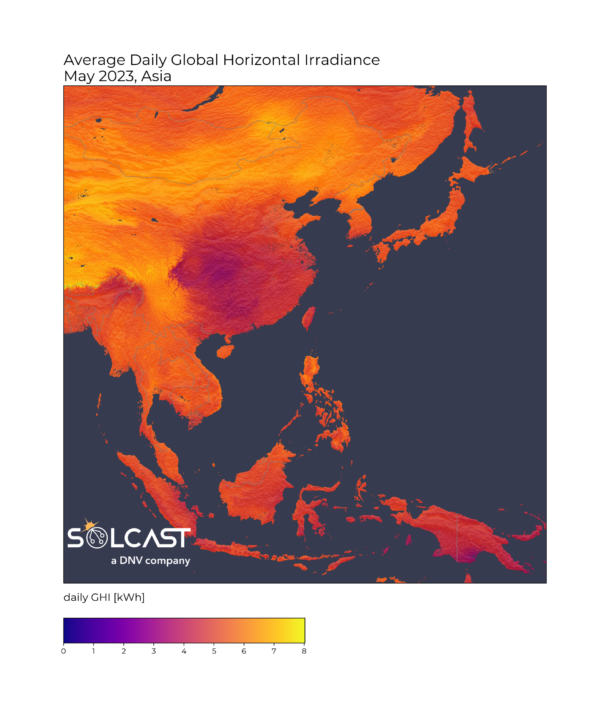Large areas of South-East Asia including Laos, Cambodia, and Thailand saw solar irradiance 10% to 30% above the long-term expectation in May 2023. Solar producers in this region benefited from higher than average generation compared to average conditions according to data collected by Solcast, a DNV company, via its Solcast API Toolkit.
The high pressure regime that caused record-high temperatures in large parts of Asia at the end of April has largely persisted into May, with below average rainfall and a slow start to the Monsoon.

In April, many temperature records were shattered in South-East Asia in a heatwave that the World Weather Attribution defined as a “once-in-200-years event that would have been “virtually impossible” without human-caused climate change.” An anomalous high over Siberia persisted in May, with the heat pervading the region: Vietnam’s all-time temperature record was broken in early May, reaching close to 45°C.


The dry weather in South-East Asia was counteracted by cloudier than usual weather in Northern China and South Korea, which generally saw solar irradiance at 80% to 90% of the long-term expectation for May.
Most of Japan saw broadly typical total solar irradiance for the month of May. However, irradiances were about 10% above average for the northern island of Hokkaido, associated with drier conditions over Siberia.
Total solar irradiance was highest over the Tibetan plateau, where a thinner atmosphere means more sunlight reaches the surface.

Solcast produces these figures via its irradiance forecasting and weather API by tracking clouds and aerosols at 1 to 2 km resolution globally using satellite data and proprietary AI/ML algorithms. This data is used to drive irradiance models, enabling Solcast to calculate irradiance at high resolution, with typical bias of less than 2%, and also cloud-tracking forecasts. This data is used by more than 300 companies managing over 150 GW of solar assets globally.
The views and opinions expressed in this article are the author’s own, and do not necessarily reflect those held by pv magazine.
This content is protected by copyright and may not be reused. If you want to cooperate with us and would like to reuse some of our content, please contact: editors@pv-magazine.com.



By submitting this form you agree to pv magazine using your data for the purposes of publishing your comment.
Your personal data will only be disclosed or otherwise transmitted to third parties for the purposes of spam filtering or if this is necessary for technical maintenance of the website. Any other transfer to third parties will not take place unless this is justified on the basis of applicable data protection regulations or if pv magazine is legally obliged to do so.
You may revoke this consent at any time with effect for the future, in which case your personal data will be deleted immediately. Otherwise, your data will be deleted if pv magazine has processed your request or the purpose of data storage is fulfilled.
Further information on data privacy can be found in our Data Protection Policy.